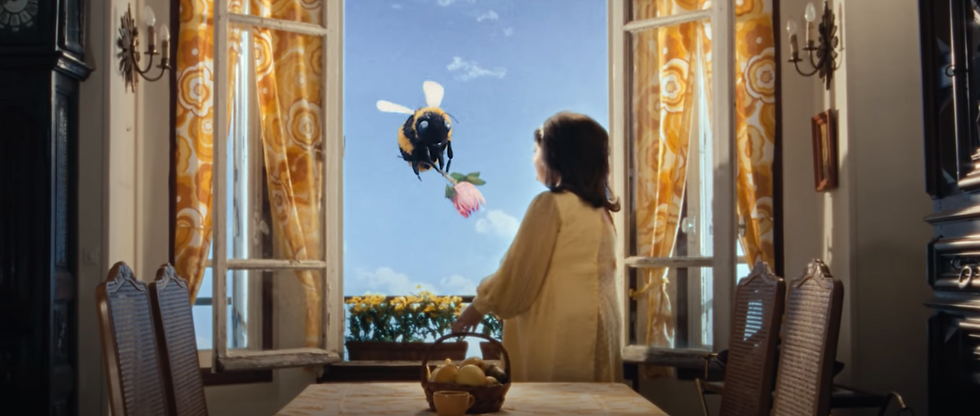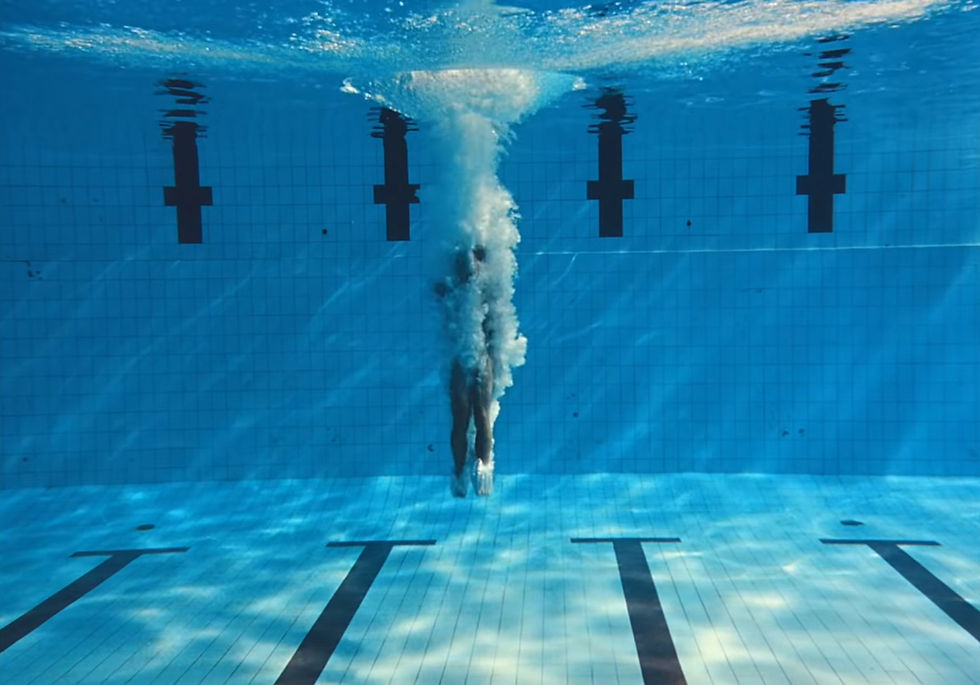TURTLE DOVES AND PIGEON SHIT
- Taylor Joe Berger

- Apr 18, 2022
- 7 min read
Updated: Apr 19, 2022

After the very recent release of James Blake's new album Friends That Break Your Heart (2021) I want to take this opportunity to revisit the essay on the music video for Can't Believe The Way We Flow, released in 2019, where we are confronted with romantic gestures, pigeon shit and a rough looking older cupid carrying a heavy gun.
Romanticism could be argued to be outdated, but once we look beyond the clichés and grasp the ideas behind it, we become aware of its relevance today; in how we live, in what we believe and in what we argue about.
James Blake released the album Assume Form in 2019. The video for Can’t Believe The Way We Flow was directed by none other than Frank Lebon. Lebon's approach to his videos and work so far has been a lush and somewhat wild mixture of techniques and media, leaving him with a massive pot of footage and tools for the hours upon hours he spends editing. To some degree even this approach of mixed media is in a sense very true to the fashion, believe and tradition of romanticism. This and many other aspects of the video, is what I hope to discuss and further investigate in this TRCKMG entry.
ROMANTICISM
I am not referring to roses, boxes of chocolates and the number of red silk bows we see on Valentine's Day. I hereby am referring to an epoch also known as the Romantic Period. Speaking roughly of romanticism we think of a time between the end of the 18th towards the end of the 19th century. This slice of our history is marked by many very major political and cultural events across Europe and the globe. Some worth mentioning here would be the French revolution (which is often believed to be a starting point of the French romanticist movement) and the industrialization, characterized by heavy machinery, steam engines, factories and therefore factory labour. We do, however, believe that the origin of romanticism as a term and way of thinking lies in Germany. Friedrich Schlegel, a German philosopher, author and poet first used the term 'romantisch' believed to be in reference to the word 'Roman', German for novel, so romantic therefore being 'novel-like'.
From there on romanticism spread fast across Europe supported by the events described earlier. More than just a fashionable moment, romanticism describes a different way of thinking in direct contrast (and perhaps in protest) to the inhumane labour happening in factories caused by the industrial revolution. People needed to believe in something, in more relevant things, in nature, in purity, in emotion and in beauty. So not surprisingly romanticism maneuvred like a wave, spreading across fine art, literature, poetry and even medicine. What we can see in many paintings of that time, are vast and lush landscapes. Nature at its most triumphant, often alongside a tiny human figurine, humbled by mother nature, reminding the human of his place and scale in this world. This emphasized by James' lyric "I'm finding I'm a smaller piece than I thought. Oh no I really am". Even back then, the immediate threat of our natural world was carefully depicted in William Wordsworth's poetry with the arrival of factory buildings and nearby compounds of living quarters for the workers. With this very surface level introduction to romanticism it is time to take a close look at the video.

(Painting, Hans Gude, Fra Hardanger, 1847)
RED LIT COUPLES

(Still, James Blake, "Can't Believe The Way We Flow", 2019)
The video starts off with a zoom into a mirror. The reflective image reveals James sitting on a bench. The close-up is made with 'invisible cuts' while dark silhouettes pass by, covering James for a mere flash of a completely blacked out frame. He appears closer and closer after each such black out. Meanwhile you can hear the pigeons take flight, signalling a start to the song and video – take off. And with the first bird shit landing on James' cheek, it is clear the video with its main plot now begins and the subjects appear.
The second time we hear "Can't believe the way we flow” in the lyrics, the lips of the red lit couples meet. The images flashing by are mere fragments out of their lives in a relationship. We are not meant to immediately understand who they are, where they are coming from and maybe more importantly what they are up to. We only see aspects that should be familiar to anyone who has ever been in a relationship. For instance, being the most intimate during breakfast where spontaneous conversations can leave you happy as ever or absolutely gutted and devastated, also depending on what occurred the night before.
Another place where we find a kind of intimacy where the shared space really gets noticeable to us as lovers, is the bathroom. So, apart from the hints of breakfast scattered throughout the video there is also the toilet. Waste. The toilet which stereotypically but truthfully always seems to spark arguments. Flush the damn thing, put the seat down, put it up and then down. But it is also the same space in which we share our toothpaste, standing in front of the mirror before bed. Leading conversations whilst getting ready to go out together. The point being, these images are highly familiar and highly emotional to us. The small window in which Lebon lets these images flash across our screens is enough for us to recognize and connect. These are couples in their banalities. We are not meant to understand how they got there and where they are going. We are supposed to draw from our own experience, our own relationships when seeing these fragments and glimpses into their lives. It is a reflection. We still are staring into that mirror from the first shot of the video.

(Still, James Blake, "Can't Believe The Way We Flow", 2019)
Cut between the kisses is a 2D animated kiss, in the same style as the quick drawing we saw flash by on a table earlier. It might be a glimpse into the storyboard for the video, adding another layer and texture to the visuals. This approach alone can also be read as a nod to romanticism as there was a high exchange between different media and artists. Poets and painters, novelists and sculptors. All echoing and responding to each other's work.
Throughout all of this we see James remaining on that same bench, from the very first frame of the video. An observer. In romanticism, as a response to the capitalist mentality, the flâneur was born and celebrated. The flâneur describes a person seen wandering around with nowhere to be or go. Observant, most likely unemployed, playful and sensitive to his surroundings. James is very likely maintaining this role in the video. The careful bystander, observing the beauty around him. Beauty that lies hidden for most others in their hectic lives.
PIGEONS, GUNS AND CUPID

(Still, James Blake, "Can't Believe The Way We Flow", 2019)
A culmination of shots of pigeons (and some seagulls) in flight. A close-up of a pigeon's face, slowly revealed to be sitting on someone’s head. This someone is Frank Lebon's dad, photographer Mark Lebon. And here he is also cupid. A cupid who has aged and traded his bow and arrow off for a knotted sniper gun.
Cupid is often described as a winged, nude young boy armed with bow and arrow. He is usually depicted as somewhat cruel and mischievous, very aware of what emotional turmoil he can cause in people. Cupid as a figure derives from roman mythology and is considered to be the god of love, or rather the god of being in love. The roman cupid is also understood to be based on the Greek god Eros, who was a son to the goddess Venus. Both of which cannot be defeated, any- and everyone falls victim to them and their power. In the following painting, artist Julius Kronberg captured Cupid in his full demeanour:

(Painting, Julius Kronberg, Cupid, 1885)
Now in comparison to Frank Lebon's take on Cupid we immediately notice the age difference. The world in many ways has become what romanticists had feared; industrial, concrete, consumerist. Perhaps cupid had to adjust to survive, lose his wings and grow up. Wrapped in what seems to be a PVC outfit, not unlike the medical protective suits we currently see a lot. His outfit also contains sketches and scribbles of genitalia. Colours white and red, famously used in the medical field, also symbolizing purity, lust, sin and romance. He is also wearing red earrings and cufflinks decorated with a more traditional depiction of Cupid.
The gun on the other hand, knotted, could also be a nod to the Non-Violence sculpture by Carl Fredrik Reuterswärd, which is in New York. Perhaps a rather twisted musical reference, as that sculpture was made in remembrance of John Lennon.
The seemingly unusable gun however, does hold a heart shaped scope, through which the absent minded and complacent looking Cupid is aiming to find his next victims.
Enrolling the pigeons to take over the flying and "firing arrows" part, they soon after take flight once again and a montage of numerous bird shit landings are shown, including another drawn animation of the pigeons' shit turning into a falling human figurine. Perhaps falling, as in falling in love, falling for you. Cupid bringing or rather dropping this person into your life. This sequence is concluded by acts of violence and tenderness. A slap, a hit, like when love "hits" you. Shortly followed by a gentle caress of the cheek, as though nothing ever happened. So in love that you are not aware of the violence and force it potentially holds. Another short animation, single flower turns into a tree, which transforms into a couple in love, a heart in the middle.
FEATHER CUSHIONS
Cut to seagulls instead of doves above James. Perhaps accentuating him to be different from all others around him, once again emphasizing his role as flâneur? Or maybe it`s just a subtle teaser for his following music video for “I`ll come too”, which was the next release featuring a penguin and an albatross.
The couples, still lit in red are holding hands, and then facing the camera. Every individual on their own, staring into the lens, or at their partner. Keeping the mirror in mind from the beginning, this is another very common way for cinema, film, video to become reflexive (film with self-awareness) challenging the viewer in their passiveness and voyeurism.

(Still, James Blake, "Can't Believe The Way We Flow", 2019)
The doves once again present by appearing as illustrations on the cushions of one couple. All the people involved appear in lettering over the faces of the couples, including a cameo by the director. Another beautifully added layer to this multimedia approach that lends its charm and texture to the entire complex romantic experience.
There is so much more to see and discover in the video than what I have tried to contain in this analysis. I do hope you will go on a search yourselves.






Comments